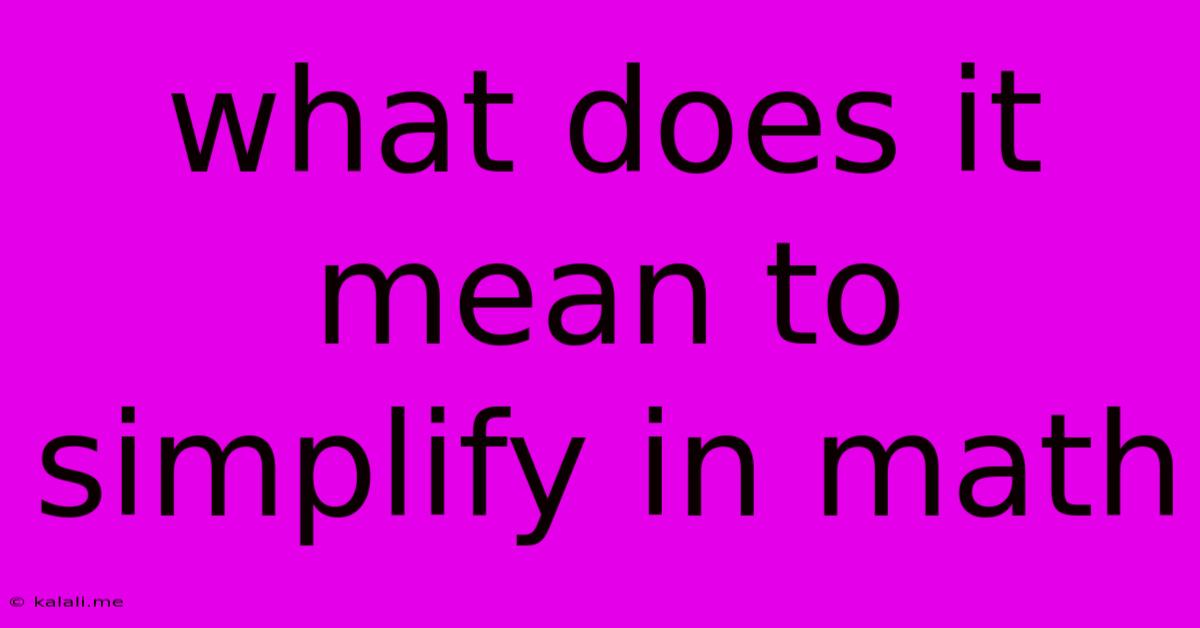What Does It Mean To Simplify In Math
Kalali
Jun 09, 2025 · 3 min read

Table of Contents
What Does it Mean to Simplify in Math? A Comprehensive Guide
Simplifying in math means writing a mathematical expression in its most concise and understandable form. This often involves reducing complexity without changing the expression's value. It's a fundamental skill crucial for solving equations, understanding concepts, and making calculations easier. This guide will explore various aspects of simplification across different mathematical areas.
Why is Simplifying Important?
Simplifying mathematical expressions offers numerous benefits:
- Clarity: Simplified expressions are easier to understand and interpret. Complex equations can be overwhelming, but a simplified version reveals the underlying structure and relationships.
- Efficiency: Simplified expressions make calculations faster and more efficient. Less work means a reduced chance of errors.
- Problem Solving: Simplification is often a necessary step in solving more complex mathematical problems. Without simplification, many equations would be practically impossible to solve.
- Pattern Recognition: Simplifying can reveal underlying patterns and relationships within an expression that might not be apparent in its more complex form. This is particularly useful in advanced mathematics.
Methods of Simplification:
The methods for simplifying depend heavily on the type of mathematical expression. Here are some common techniques:
1. Simplifying Arithmetic Expressions:
This involves using the order of operations (PEMDAS/BODMAS) and basic arithmetic principles:
- Combining like terms: Adding or subtracting terms with the same variable raised to the same power (e.g., 3x + 2x = 5x).
- Using distributive property: Expanding expressions by multiplying a term by each term within parentheses (e.g., 2(x + 3) = 2x + 6).
- Reducing fractions: Dividing both the numerator and denominator by their greatest common divisor (GCD) (e.g., 6/9 simplifies to 2/3).
- Evaluating exponents and roots: Simplifying expressions containing exponents and roots using exponent rules (e.g., x² * x³ = x⁵).
2. Simplifying Algebraic Expressions:
Algebraic expressions involve variables and constants. Simplification here often involves:
- Combining like terms: Similar to arithmetic, combining terms with the same variable and exponent.
- Factoring: Expressing an expression as a product of simpler factors (e.g., x² - 4 = (x-2)(x+2)). This is extremely helpful in solving equations and simplifying rational expressions.
- Expanding: Using the distributive property to remove parentheses and combine like terms.
- Rationalizing denominators: Removing radicals from the denominator of a fraction by multiplying the numerator and denominator by the conjugate of the denominator.
3. Simplifying Trigonometric Expressions:
Trigonometric expressions involve trigonometric functions like sine, cosine, and tangent. Simplification might use:
- Trigonometric identities: Equations that are true for all values of the variables. These identities allow for rewriting expressions in simpler forms. (e.g., sin²x + cos²x = 1).
- Factoring and canceling: Similar to algebraic expressions, factoring and canceling common factors can simplify trigonometric expressions.
4. Simplifying Expressions with Radicals:
Radicals (square roots, cube roots, etc.) can be simplified by:
- Factoring: Finding perfect squares (or cubes, etc.) within the radicand and taking them out of the radical. (e.g., √12 = √(4*3) = 2√3).
- Rationalizing denominators: Removing radicals from the denominator.
Examples of Simplification:
- Arithmetic: 10 + 5 - 2 * 3 = 10 + 5 - 6 = 9
- Algebra: 3x + 2y - x + 5y = 2x + 7y
- Algebra (Factoring): x² + 5x + 6 = (x+2)(x+3)
- Radicals: √75 = √(25 * 3) = 5√3
Simplifying mathematical expressions is a fundamental process that improves clarity, efficiency, and problem-solving capabilities across various mathematical fields. Mastering these techniques is essential for success in mathematics. Remember to always follow the order of operations and utilize the appropriate techniques based on the type of expression you're working with.
Latest Posts
Latest Posts
-
How Long Can A Peanut Butter And Jelly Sandwich Last
Jun 09, 2025
-
How To Change Stats Rpg Maker Mv
Jun 09, 2025
-
Yellow Robot With Display For Face
Jun 09, 2025
-
Type Emojis In Mac Messenger Just Like Slack
Jun 09, 2025
-
Sausage Party Ending Of The Movie
Jun 09, 2025
Related Post
Thank you for visiting our website which covers about What Does It Mean To Simplify In Math . We hope the information provided has been useful to you. Feel free to contact us if you have any questions or need further assistance. See you next time and don't miss to bookmark.